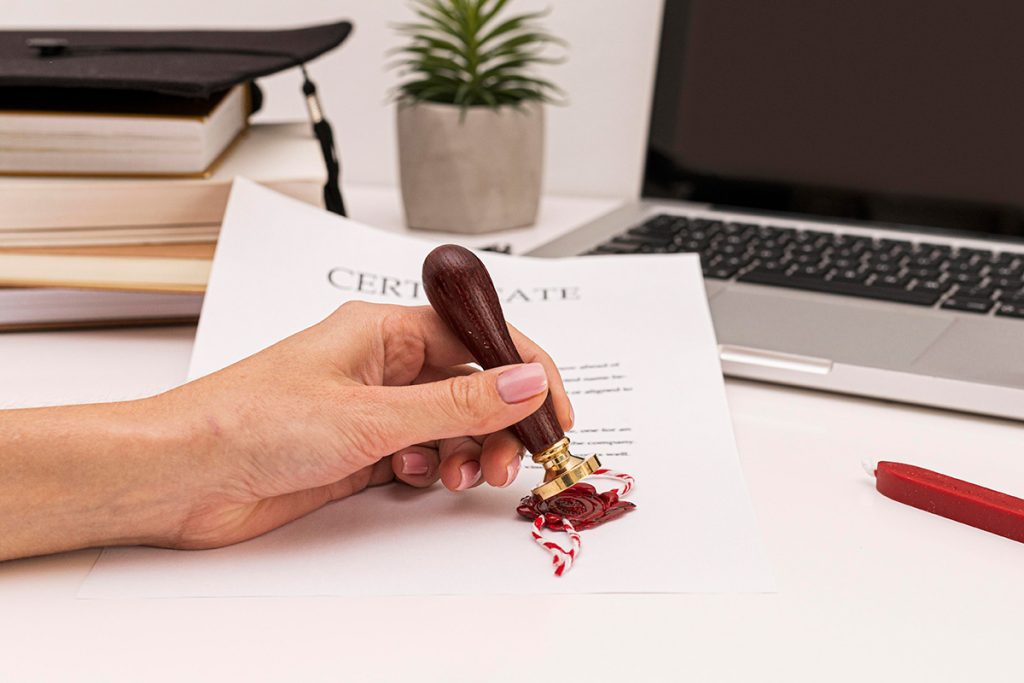
Improper Notary Stamp and Seal Usage: Detailed Explanation
As a notary public, your stamp and seal are more than just tools — they’re official marks that authenticate your work. However, many notaries, especially new ones, unintentionally misuse their seal or stamp, risking legal consequences, rejected documents, or even revocation of their commission.
Table Of Content
- 📌 What Is a Notary Stamp and Seal?
- 🔹 Notary Seal
- 🔹 Notary Stamp
- ❌ Common Mistakes in Notary Stamp and Seal Usage
- ⚠️ 1. Stamping in the Wrong Location
- ⚠️ 2. Using an Expired or Incorrect Stamp
- ⚠️ 3. Stamping Without a Notarial Act
- ⚠️ 4. Using a Seal That Doesn’t Meet State Standards
- ⚠️ 5. Stamping More Than Once
- 🛡️ Legal and Professional Risks of Improper Use
- 🧠 Best Practices for Proper Stamp Usage
- ✅ Always Double-Check
- ✅ Use a Practice Sheet
- ✅ Store Safely
- ✅ Replace When Worn
- 🏛️ What the Law Says: State-Specific Rules
- 🧾 Checklist: Before You Stamp
- ✍️ Final Thoughts
This guide breaks down the most common notary stamp and seal mistakes, why they matter, and how to avoid them. Whether you’re just starting out or have years of experience, it’s always good to double-check that you’re using your tools properly and legally.
📌 What Is a Notary Stamp and Seal?
Let’s clarify the difference:
🔹 Notary Seal

Traditionally an embosser that leaves a raised impression on the paper. Still used in many states but often not required.
🔹 Notary Stamp

Usually a rubber or self-inking stamp that includes your name, commission number, expiration date, and jurisdiction.
Most states now require or accept the ink stamp as the official notarial seal.
⚠️ Note: Requirements for notary seals vary by state. Always check your state’s laws before purchasing or using your seal.
❌ Common Mistakes in Notary Stamp and Seal Usage
Improper usage may seem harmless, but it can invalidate documents and expose you to liability.
⚠️ 1. Stamping in the Wrong Location
- Mistake: Placing your stamp over text or signatures.
- Why it matters: Makes the document unreadable or unacceptable for recording.
- How to fix it: Always place the stamp in a clear space near your notarial certificate—never on top of other writing.
⚠️ 2. Using an Expired or Incorrect Stamp
- Mistake: Using a stamp with outdated commission information.
- Why it matters: Invalidates the notarization and can be considered fraud.
- How to fix it: Order a new stamp immediately when your commission is renewed or updated.
⚠️ 3. Stamping Without a Notarial Act
- Mistake: Applying your seal to a document without administering an oath or acknowledgment.
- Why it matters: Your seal isn’t a decorative tool — it must accompany a proper notarial act.
- How to fix it: Only stamp after completing the proper notarial certificate and process.
⚠️ 4. Using a Seal That Doesn’t Meet State Standards
- Mistake: Using a round embosser when your state requires a rectangular ink stamp — or missing key information.
- Why it matters: Documents could be rejected by courts or recorders.
- How to fix it: Verify your state’s specifications (size, format, ink color, content) and make sure your seal complies.
⚠️ 5. Stamping More Than Once
- Mistake: Applying multiple stamps to “fix” a faint or blurry impression.
- Why it matters: Creates confusion or may be seen as tampering.
- How to fix it: If the impression is unclear, draw a single line through it, write “VOID,” and re-stamp clearly nearby.
🛡️ Legal and Professional Risks of Improper Use
Incorrect stamp use doesn’t just cause paperwork headaches — it can have serious consequences.
| 🚫 Risk | 💬 What Can Happen |
|---|---|
| Document rejection | County clerk or court may refuse to accept it |
| Financial penalties | Fines for improper notarization |
| Civil lawsuits | Liability if your mistake causes harm |
| Disciplinary action | Suspension or revocation of notary commission |
| Fraud charges | If the misuse appears intentional |
Real-life example: A notary in Texas was fined $500 and had their commission suspended for using a stamp missing their commission expiration date — something that could’ve been easily avoided.
🧠 Best Practices for Proper Stamp Usage

Avoid errors and maintain professionalism by following these best practices:
✅ Always Double-Check:
- Date, name, and commission info on your stamp
- Proper placement near the notarial certificate
- That the stamp is clean and legible
✅ Use a Practice Sheet
- Keep a blank page handy to test your stamp if it hasn’t been used in a while.
✅ Store Safely
- Lock up your stamp/seal when not in use.
- Never lend it — even to another notary!
✅ Replace When Worn
- If the impression is faded or smudged, replace the stamp immediately.
🏛️ What the Law Says: State-Specific Rules
Here are a few examples of state regulations that show how different the rules can be:
| 📍 State | 🔎 Requirement |
|---|---|
| California | Must use a rectangular ink stamp with black ink |
| Florida | Must include “Notary Public - State of Florida,” name, commission number, and expiration date |
| Texas | Requires a border, commission date, and “Notary Public, State of Texas” wording |
| New York | Embossers optional, ink stamp encouraged, must include name and county of qualification |
Pro tip: Visit your Secretary of State’s website to download official notary guidelines.
🧾 Checklist: Before You Stamp

Use this quick checklist before applying your notary seal or stamp:
✅ Have I completed the notarial certificate?
✅ Have I verified the signer’s identity?
✅ Am I using the correct and current stamp?
✅ Is the placement clear and not overlapping any text?
✅ Is the stamp readable and properly formatted?
✅ Have I recorded the act in my notary journal (if required)?
If you answer “no” to any of these, stop and fix the issue before proceeding.
✍️ Final Thoughts
Your notary stamp and seal carry weight — they’re symbols of trust, legality, and authenticity. Using them improperly, even unintentionally, can create legal problems and hurt your reputation.
The good news? With a little care and awareness, you can avoid common stamp-related pitfalls and notarize with confidence. Remember, being a notary isn’t just a title — it’s a responsibility. Treat your tools with the same respect you give your role, and you’ll stay compliant and professional.


